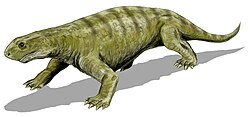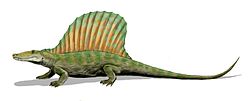| Remigiomontanus Temporal range: Late Carboniferous - Early Permian | |
|---|---|
 | |
| Holotype specimen, UGKU 1997 | |
| Scientific classification | |
| Kingdom: | Animalia |
| Phylum: | Chordata |
| Clade: | Synapsida |
| Family: | † Edaphosauridae |
| Genus: | † Remigiomontanus Spindler, Voigt & Fischer, 2019 |
| Type species | |
| †Remigiomontanus robustus Spindler, Voigt & Fischer, 2019 | |
Remigiomontanus is an extinct genus of non-mammalian synapsids belonging to the Edaphosauridae. The type species is R. robustus. [1]





